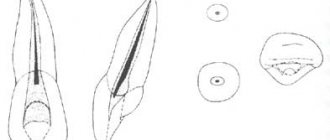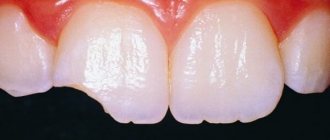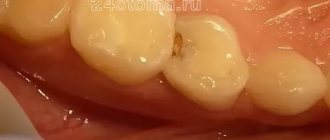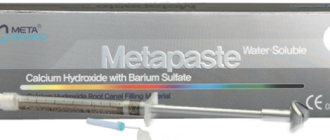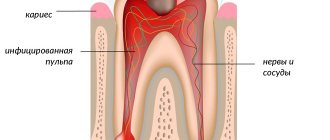Author: Brodsky Sergey Evgenievich Deputy Chief Physician, Candidate of Medical Sciences in the specialties: dentistry and medical microbiology In the clinical practice of dentists, there are often cases of people who have had dental canals refilled and have developed pain in them afterward. In this case, there is no need to panic right away, because pain in the tooth after root canal retreatment may persist for 3–5 days. However, if the painful sensations, which most often appear when biting, persist for a long time, you need to contact an experienced dentist.
Causes of pain
When going to the dentist to eliminate a problematic situation with a tooth, the patient believes that if a filling is placed, nothing else will bother him. This doesn't always happen. There are many reasons why toothache makes you visit the dentist again.
Among them are violations of filling technology:
- Incomplete drying of the tooth cavity during surgery.
- does not adhere to the tooth, resulting in an empty area that becomes the cause of infection.
- Poor (incomplete) removal of caries.
- In cases of advanced tooth decay, preliminary treatment of the cavity using a temporary filling is necessary. If the doctor does not perform anti-inflammatory treatment, toothache under the filling can be intense, as the inflammation in the enclosed space progresses.
- Painful sensations that appear due to damage to the enamel during surgery.
Toothache after temporary filling
Penetration of infection deep into the hidden layers of teeth inevitably entails treatment associated with the removal of damaged tissue and nerve endings.
In addition to violating the filling installation technology, painful sensations can be caused by an allergy to the material used for this purpose.
Sometimes the patient himself is to blame for the occurrence of pain - he does not follow the doctor’s recommendations, which include gentle loads regarding eating and drinking. This leads to damage to the installed seal and its tightness due to incomplete hardening of the sealing composition.
Features of dental canal treatment
Differences in the structure and functions of the “representatives” of the dentition largely determine the nature of the treatment approach. Treatment of canals for different groups of teeth has its own nuances.
Front tooth canal treatment
The front teeth most often have one canal. They are often curved and difficult to pass through for instruments. In order to preserve aesthetics, the opening of the cavity of these teeth is carried out from the vestibule of the oral cavity. Due to their frontal location, it is important to prevent tooth enamel from darkening, so filling materials containing dyes are not used.
Treatment of wisdom tooth canals
Wisdom teeth can have more than 5 canals; they often have a branched structure, which is not always revealed by x-ray examination. These factors, along with the marginal location of the “eights”, significantly complicate the high-quality treatment of root canals. At the final stage of treatment, various filling pastes are traditionally used.
Root canal treatment of temporary teeth
Endodontic treatment of tooth root canals is usually used only at the stage of root stabilization. When choosing the optimal treatment tactics, it is necessary to take into account the specific structure of temporary teeth. The small thickness of the canal walls, the insignificant degree of dentin mineralization and the relatively large size of the apical foramen are the main reasons for special caution during instrumentation. Zinc oxide eugenol and iodoform pastes, as well as materials based on calcium hydroxide, are usually used as filling agents. They are not toxic to the permanent tooth germ and are able to dissolve along with the temporary root.
How long can the pain last?
The process of enamel destruction is gradual and often painless. Therefore, patients rarely see a doctor in a timely manner. But the result of these changes is the same - the inflammatory process provokes diseases such as:
- caries;
- pulpitis;
- periodontitis.
Treatment consists of performing an operation with mechanical impact on the tooth cavity in order to treat the damaged areas and subsequent filling. Such intervention in some cases provokes post-filling pain. Their appearance or absence depends on the level of preparedness of the dentist, the severity of the inflammatory process, and compliance with hygiene rules.
It should be noted that many people experience toothache immediately after surgery. This is a common reaction of damaged nerve endings to dental intervention, which goes away quickly. Sometimes the pain syndrome continues for 2-3 days and occurs without much intensity.
If pain is felt for several hours after filling or discomfort appears when pressing for the next 3-5 days, such manifestations should not cause alarm. In most cases, such symptoms are explained by the patient’s excessive sensitivity. They can be relieved with painkillers or anti-inflammatory drugs.
Why can our articles be trusted?
We make health information clear, accessible and relevant.
- All articles are checked by practicing doctors.
- We take scientific literature and the latest research as a basis.
- We publish detailed articles that answer all questions.
After root canal filling, pain may persist for 3-4 weeks. Every day these sensations decrease. If pain persists and gum swelling does not go away, you should consult a dentist.
When a tooth aches for several days after treatment, there is reason to visit the dentist again. Using x-rays, he will determine the cause of painful manifestations and eliminate them.
A situation in which the pain does not go away for a long time does not allow self-medication with analgesic drugs.
This leads to serious complications. To avoid them, you need to consult with your doctor, who, if indicated, will perform pulp removal and cleaning of the dental canals.
What materials are used to fill canals?
The main requirements for such filling materials are dense, hermetically sealed filling of the canals, chemical inertness (the material should not dissolve under the influence of body fluids), radiopacity (it should be clearly visible in the picture). Today, the following types of materials are used for filling dental canals:
- Solid fillers (fillers).
These include gutta-percha (a latex processing product), silver and titanium pins. Silver pins have recently been rarely used, since despite their good antibacterial properties they have a significant drawback - they do not provide complete tightness. - Polymer and natural pastes (sealers)
. A more preferable option is polymer sealers, which adhere better to the walls, do not stain dental tissue and do not dissolve when interacting with tissue fluids. - Glass ionomer cements.
Good adhesion and radiopacity, high biocompatibility and minimal shrinkage are the main positive qualities of such materials. They also have significant drawbacks: low strength, which is why such fillings are short-lived and not designed for serious functional loads. - Calcium hydroxide cements
. Non-toxic, biocompatible, radiopaque materials that exhibit minimal shrinkage, are easily removed if necessary and have bactericidal properties. However, they are considered not too strong and can break under heavy loads on the dental crown. - Polydimethylsiloxanes
. Modern reliable sealants with good therapeutic and operational parameters. Perhaps their only drawback is that this is a new product on the dental market and experience in using such materials has not yet been accumulated. There is no reliable information yet about the experience of patients after such treatment.
In case of inflammation of the tooth canals, the dentist selects the treatment individually, taking into account the type of dental unit, the number and shape of the roots, the patency of the root canals and the further plan for restoring the crown. Taking these factors into account, the filling material is also selected. Many specialists combine materials to achieve optimal characteristics and tightness of closing cavities. Filling techniques
Just 10-20 years ago, the main method of filling dental root canals was to fill them with one type of cement. This is a very simple and not labor-intensive method, but for the patient it has a lot of disadvantages: the channels are filled poorly and unevenly, voids appear in which microbial infection can develop. In addition, such cements quickly shrink and the canals soon have to be re-treated.
Modern dentistry offers completely different filling methods:
- Depophoresis
is the hardware introduction of medicinal and filling materials into the root canal. The technique allows you to effectively fill even curved and hard-to-reach canals. - Obturation with thermophiles
(plastic carriers coated with gutta-percha). A fast, fairly simple and reliable method, which still has the disadvantage of the possibility of material being removed beyond the root tip. - Filling with gutta-percha pin
. - Lateral condensation
is a dense filling of the canals with gutta-percha pins coated with a hardening sealer. A fairly reliable method, however, when using it there is a high risk of tooth root fracture. - Thermomechanical
(sometimes also called rotating condenser sealing) condensation. Recently, it has been used very rarely due to the high risk of complications. - Vertical condensation of heated gutta-percha
. A rather complex and lengthy, but at the same time reliable and durable filling method. - Injection filling with hot gutta-percha
. - Injection of heated gutta-percha
using the continuous wave method. One of the options for vertical condensation, characterized by greater simplicity and at the same time sufficient reliability and tightness of filling the channel. - Thermoplastic injection
of hot gutta-percha. A simple and fast method, which, however, does not always make it possible to densely fill the lateral tubules. - E&Q Plus
is a mixed technique using an injection gun to inject gutta-percha into the canal.
If you have a problem similar to that described in this article, be sure to contact our specialists. Don't diagnose yourself!
Why you should call us now:
- We will answer all your questions in 3 minutes
- Free consultation
- The average work experience of doctors is 12 years
- Convenient location of clinics
Single contact phone number: +7
Make an appointment
Means for relieving discomfort
It is advisable to endure moderate pain if it lasts no more than three days. During this period, damaged tissues and nerve endings will be restored, which will help eliminate discomfort.
But sometimes it is not possible to do without the use of painkillers.
A qualified examination will provide the basis for prescribing an adequate course of treatment using anti-inflammatory and analgesic medications.
Based on the results of the examination, the dentist may recommend a toothpaste that reduces enamel sensitivity.
Possible complications
Not all cases go smoothly. Let's consider the main problems that arise after the procedure.
- Perforation.
The phenomenon is the formation of holes between the dental canals and surrounding tissues. Treatment of perforation consists of medicinal treatment and filling. - Cheek swelling.
The reason why the cheek is swollen after root canal treatment is believed to be the impregnation of the periodontal tissues and mucous membranes with an anesthetic drug, which themselves are quite loose and easily absorb liquid. - Instrument fracture.
The probes for passing through the channels are very thin. If they break during medical procedures, the fragments are removed with special devices. Modern dental instruments made of nickel-titanium alloys are less susceptible to wear and break less often. - Adverse reactions to medications.
The range and severity of side effects of modern anesthetics are minimal. Before treatment, the doctor must collect an allergic history - information about drug intolerance - and the likelihood of a full-blown allergic reaction is practically reduced to zero. Adverse reactions of moderate and minor degrees are mostly short-term, can be easily corrected or can be overcome by changing the drug. - Other complications.
Situations such as swallowing particles of fillings, tooth dust, and small instruments now practically do not occur thanks to the use of a rubber dam - a latex plate that separates the tooth or teeth being treated from the oral cavity.
In what situation should you consult a doctor?
Post-filling pain that does not go away and intensifies over time may indicate an inflammatory process. There is no point in looking for the reason on your own. It is necessary to consult a doctor without delay, since not all discomfort can be explained by tissue hypersensitivity.
Pain that does not subside for more than 4 weeks is an indication for examination. But you should not wait exactly that long if: the temperature has risen, the gums have swollen, or the general condition has worsened.
A similar picture may indicate the reasons listed above. Among them the main ones remain:
- performed in bad faith .
- Recurrent caries.
- Rejection of the filling material, accompanied by itching and rash on the skin. The filling needs to be replaced.
- A cyst is an accumulation of pus. The process develops slowly, but can lead to serious consequences, even to oncology.
- Pulpitis is a lesion of soft tissue. If infection penetrates into the apex of the tooth root during canal treatment, acute throbbing pain occurs very quickly. It intensifies when eating hot food. Immediate re-treatment of the canals is required, since anti-inflammatory drugs provide a temporary effect.
- Poor fit of the installed filling. In this case, the doctor will polish it, and the pain will disappear.
Correction is necessary in every case of poor-quality filling, because the slightest defect becomes the cause of a repeated inflammatory process.
An exceptional danger is the appearance of pus. This may indicate the occurrence of periodontitis or pulpitis, the formation of flux (inflammation of the periosteum).
To prevent the spread of inflammation, immediate contact with a specialist is required.
When is tooth canal cleaning performed?
It is necessary to treat and fill root canals in the following cases:
- If caries has progressed to pulpitis (infection has spread to the dental pulp, or colloquially “dental nerve”). The pulp will have to be removed (the tooth depulped), and the root canals in which it was located will have to be thoroughly cleaned of tissue debris and sealed.
- If it is necessary to prepare a dental unit for the installation of a crown and the doctor believes that depulpation is necessary. Previously, when installing single crowns or supporting crowns of a bridge, the teeth were necessarily subject to depulpation; now this procedure is not performed in all situations and only when installing certain types of dentures.
- If there is a need for re-treatment of the tooth after the occurrence of a secondary source of infection or with the development of periodontitis, inflammation of the tissues around the tooth root (develops with poor-quality canal filling).
In all these situations, endodontic treatment is carried out (the name comes from the Latin words “inside” and “tooth”, that is, it can be literally translated as intradental treatment) with mandatory filling of the dental canals.
If you have a problem similar to that described in this article, be sure to contact our specialists. Don't diagnose yourself!
Why you should call us now:
- We will answer all your questions in 3 minutes
- Free consultation
- The average work experience of doctors is 12 years
- Convenient location of clinics
Single contact phone number: +7
Make an appointment
Preventive measures
In order not to provoke pain after installing a filling, you must adhere to the following rules:
- Avoid eating sweets, hot and cold foods;
- reduce the load on the treated tooth, avoiding the possibility of damage to the filling in the process of chewing solid food;
- Avoid chewing gum and a toothbrush with stiff bristles.
All measures are temporary and simple, but following them will prevent possible complications.
Timely treatment of a diseased tooth and seeking help in case of pain after surgery is the basis for the successful completion of dental filling.
Prevention
If you have dead teeth, care must be taken to preserve them. A crown that does not receive nutrients is fragile. Over time, it can deteriorate and tooth mobility appears. Prevention of diseases in such diseases is very important.
It is imperative to ensure proper daily oral hygiene. Teeth should be brushed with a suitable toothpaste; the brush should not have very hard bristles. After eating, you need to rinse your mouth with special compounds. This will help get rid of food debris and minimize the risk of developing plaque, tartar, and the proliferation of pathogenic microorganisms.
It is important to undergo regular examinations by the dentist, and at the first appearance of pain or signs of disease, immediately go to see a doctor for diagnosis and treatment.
Types of dental prosthetics
The choice of crown depends on the degree of tooth decay. During the examination, the dentist decides to install a crown if the tooth can still be restored or raises the question of removing the problematic tooth and restoring it through implantation.
Dentures are divided into:
- full,
- equatorial,
- stump,
- half crown,
- pin,
- telescopic prosthesis.
What is each type of prosthetics?
✔ With complete dentures, it replaces a completely lost tooth.
✔ The equatorial one is made of metal and is used for splinting teeth.
✔ If the tooth decay is very severe, then a stump prosthesis is used.
✔ A half-crown is placed on top of the tooth, covering it completely.
✔ If the root of a tooth has been partially removed or only its root part remains, then a pin is placed in its place, which later serves as a support and strengthens the tooth. In such cases, it is also possible to use CEREC pinless technology.
Method of lethal condensation of cold gutta-percha -
In Russia, 95% of all root canals are filled using this method.
The method of lethal condensation consists in the doctor performing a number of stages, the success of which largely depends solely on the high-quality implementation of the previous stages. We are talking about the correct measurement of the length of the root canal, as well as the quality of the instrumentation performed. Lateral condensation of gutta-percha (scheme) –
- Selection of the main gutta-percha pin - the pin is selected depending on how much the root canal was expanded during mechanical treatment)
- Filling the root canal with sealer – sealer is a special paste that is used to fill the voids between gutta-percha pins. After introducing the sealer, the main pin is inserted into the canal (Fig. 14a)
- Compaction of a gutta-percha pin with a spreader - the compaction process consists of making reciprocating movements with the spreader instrument, with its help the gutta-percha is pushed towards the canal wall and space is freed up for the insertion of new gutta-percha pins. The spreader itself is shown in Fig. 14(b), and the compaction process in Fig. 14(c).
- Insertion of smaller pins and their compaction (Fig. 14 d, e, f) - up to 8-12 gutta-percha pins can be “compacted” in just one root canal. As a result, if we look at an enlarged section of the tooth root, we should see a picture like this - Fig. 17.
- X-ray control of filling - if everything is OK - we proceed to the next stage... But if we see that the canal is not filled to the top, or the pins extend beyond the root into the surrounding tissues - it is necessary to remove all the pins and start filling the canals from the beginning.
- Removing excess gutta-percha and sealer - after the canals are tightly obturated with gutta-percha and sealer, the tips of the gutta-percha pins protruding from the mouths of the root canals are cut off with a hot tool (Fig. 14 g, h). You can see what the mouths of the root canals look like before filling and after they have been cut, excess gutta-percha protruding above the mouths of the canals in Fig. 15 and 16, respectively.
- Temporary filling – After this, the tooth cavity is closed with a temporary filling. It is not allowed to fill the crown of a tooth in the same visit with filling the canals. Restoration of the tooth crown should be carried out at the next visit.
My tooth hurts, what should I do?
Toothache has little to compare in its intensity, and until receiving medical help a person cannot live a full life: it is impossible to concentrate on work, sleep becomes intermittent, eating food is complicated by the inability to chew it calmly.
Of course, problems arise in communication, since constant stress does not leave you for a minute, and it is not always possible to cope with irritability. Telo's Beauty dentists told us what to do if you are in pain and it is not possible to go to the clinic immediately.
